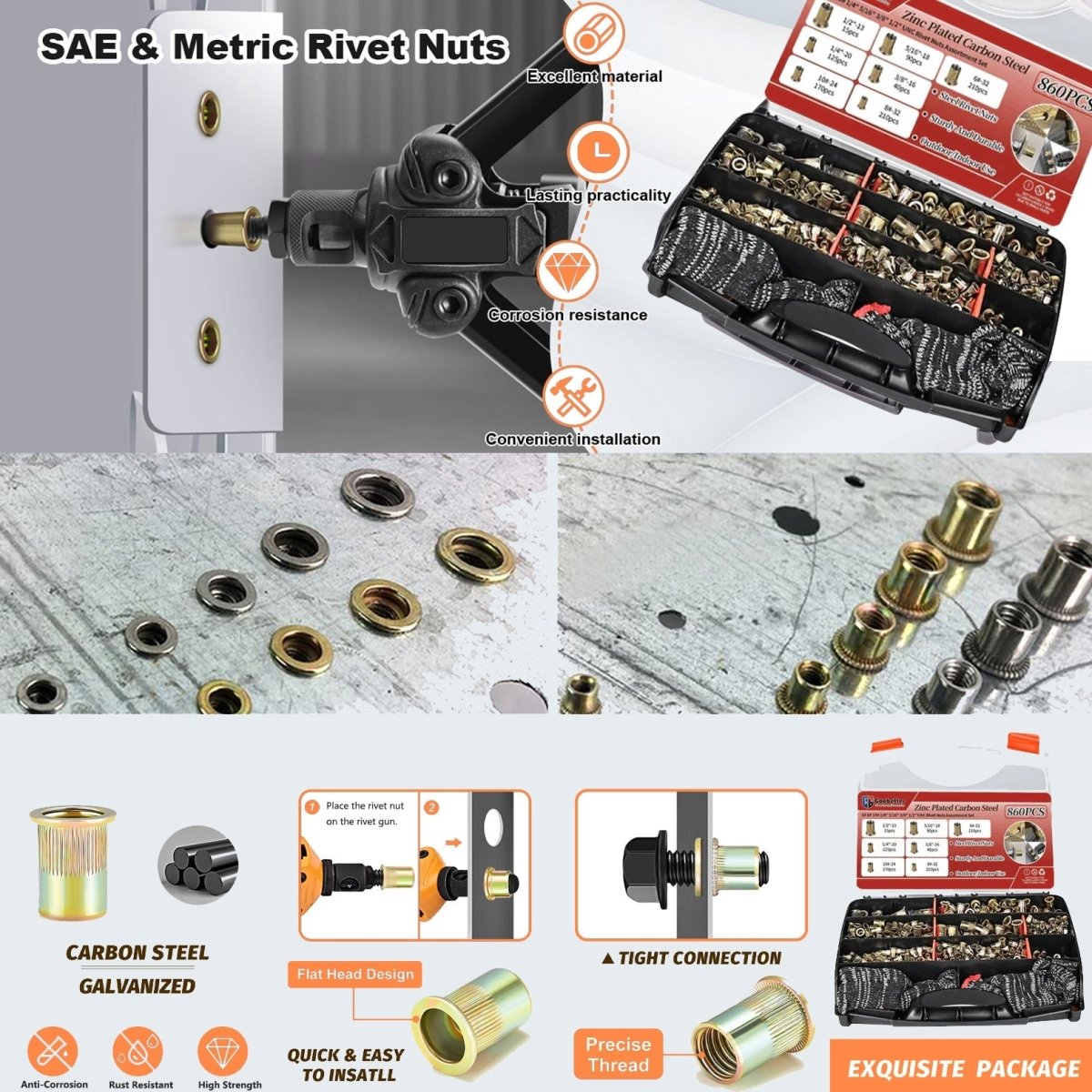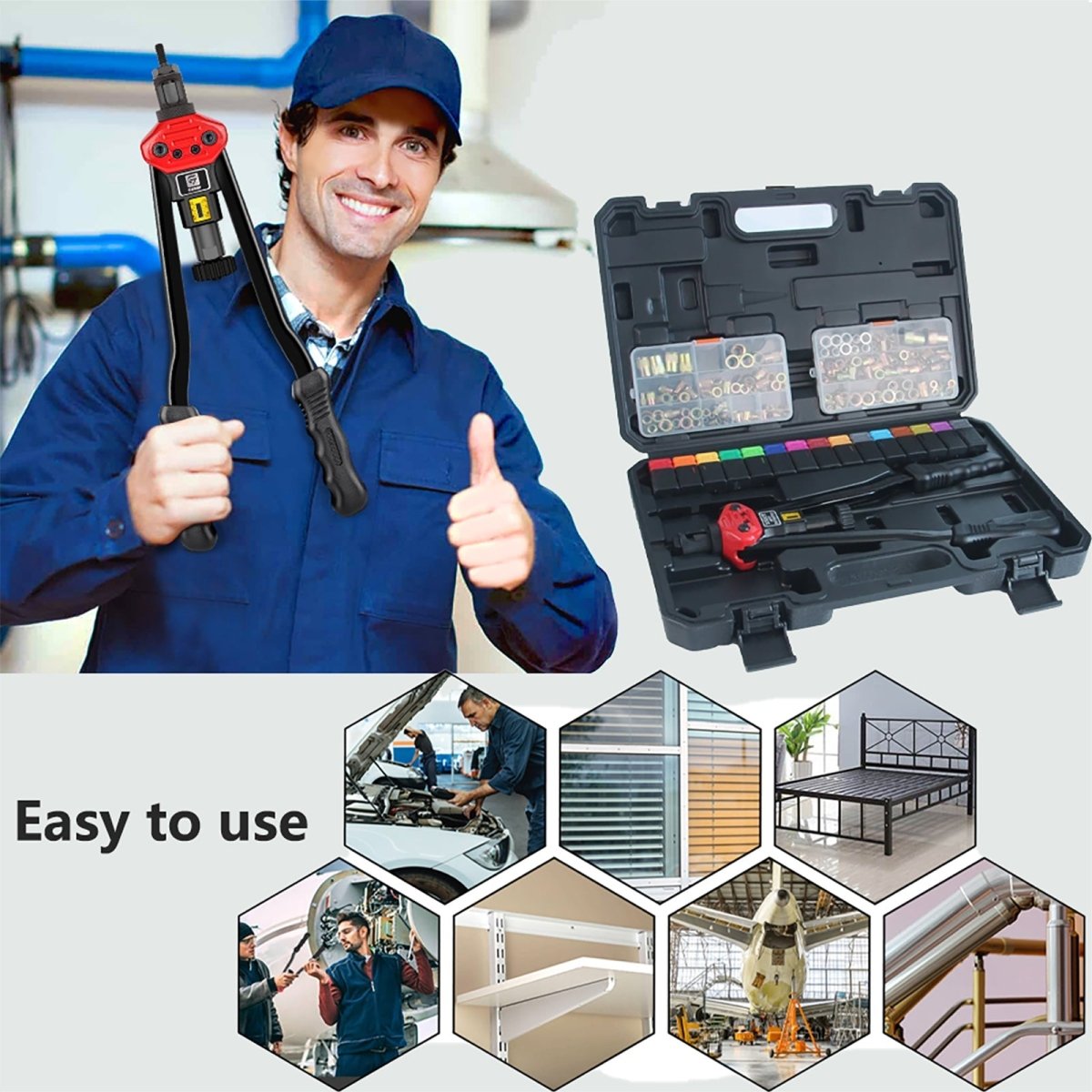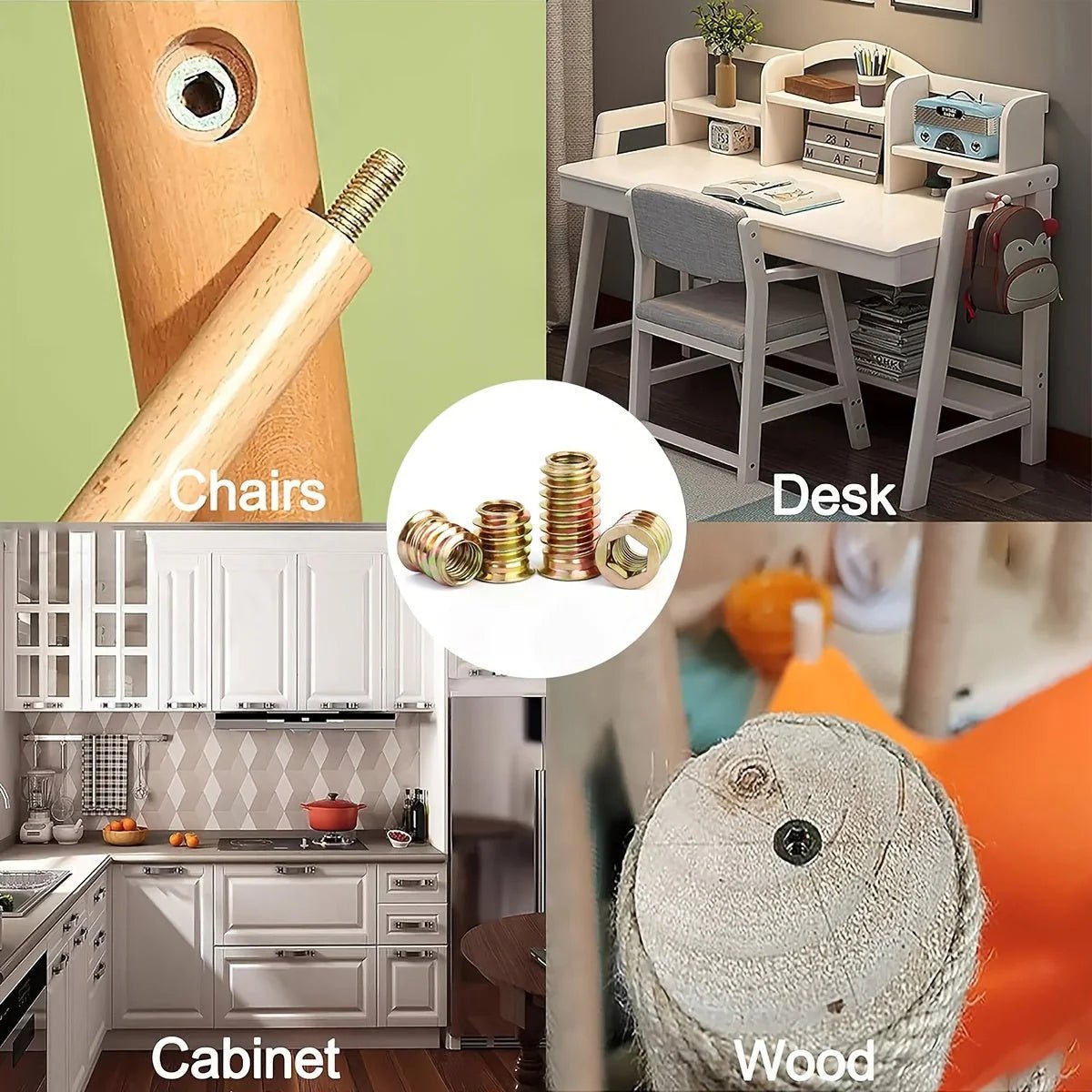Table of Contents
-
The Nightmare of Fastening Thin Metal (And How Rivet Nuts Fix It)
-
Rivet Nuts 101: What They Are & How They Work
-
Rivet Nuts vs. Welding, Tapping & Hardware: The Ultimate Showdown
-
Why DIYers & Pros Obsess Over Rivet Nuts (6 Game-Changing Benefits)
-
Real-World Applications: From Jeeps to Jet Skis
-
Installing Rivet Nuts Like a Pro (Step-by-Step Masterclass)
-
Why Our 860pc Kit Solves 90% of Rivet Nut Frustrations
-
Choosing the Right Rivet Nut: Material, Size & Grip Range
-
FAQs: Rivet Nut Mistakes, Fixes & Pro Secrets
-
Final Verdict: When to Ditch Traditional Fasteners
1. The Nightmare of Fastening Thin Metal
Picture this: You’re bolting a roof rack to your Jeep’s 1.5mm thick tub. A standard nut and bolt should work—until you realize:
-
There’s no access behind the panel (it’s a hollow cavity).
-
The thin metal strips out when you tighten the bolt.
-
Your washer and nut vanish into the frame’s abyss ("Did I just pay $0.89 to feed the metal gods?").
Traditional fasteners fail thin materials because:
⚠️ Tapped Threads: Strip under torque in metal <3mm thick.
⚠️ Welding: Warps thin sheets, requires pro tools/skills.
⚠️ Nuts & Bolts: Need two-side access (impossible in tubes/hollows).
⚠️ Self-Tappers: Rip oversized holes under vibration.
Rivet nuts (a.k.a. nutserts or threaded inserts) solve this by creating instant, load-bearing threads in materials as thin as 0.5mm—with only one-side access.
2. Rivet Nuts 101: What They Are & How They Work
Anatomy of a Rivet Nut
-
Threaded Sleeve: Internal machine threads (M3-M12 common).
-
Knurled/Hex Body: Grips host material to prevent spinning.
-
Deformation Zone: Collapses during installation to "rivet" in place.
-
Materials:
-
Aluminum: Lightweight, corrosion-resistant (trailer panels, electronics).
-
Steel: Max strength for structural loads (bumpers, engine mounts).
-
Stainless: Saltwater/outdoor use (boats, pool equipment).
-
How They Work (The Magic)
-
Drill a hole in the host material.
-
Insert the rivet nut.
-
Pull the mandrel with a tool → the sleeve compresses.
-
The knurled body bites into the host material.
-
The deformed end mushrooms behind the panel.
-
Remove the mandrel → leave perfect internal threads.
Translation: You’ve created a bolt-ready anchor point in sheet metal, plastic, or carbon fiber—with no rear access needed.
3. Rivet Nuts vs. The Competition: Brutal Honesty
| Method | Best For | Fails At | Rivet Nut Win? |
|---|---|---|---|
| Tapped Holes | Thick metal (≥5mm) | Thin sheet metal, soft alloys | ✅ (No stripping) |
| Welding | Permanent joints | Delicate electronics, painted surfaces | ✅ (No heat distortion) |
| Nuts & Bolts | Accessible two-sides | Hollow panels, tight spaces | ✅ (One-side access) |
| Self-Tappers | Speed over strength | Vibration resistance, reusability | ✅ (Load-bearing threads) |
| Epoxy/Adhesive | Non-structural bonds | Shear/torque loads, disassembly | ✅ (Mechanical bond) |
Key Takeaway: Rivet nuts dominate where traditional methods choke—thin materials, blind holes, and vibration-prone environments.
4. 6 Game-Changing Benefits (Why Pros Won’t Go Back)
-
One-Side Access: Bolt into hollow doors, tubes, or sealed panels.
-
Vibration-Proof: Won’t loosen like nuts (critical for vehicles/equipment).
-
No Stripped Threads: Steel/aluminum threads > tapped soft metal.
-
Weight Savings: Replace bulky brackets/welds with sleek fasteners.
-
Removable: Swap bolts endlessly without degrading threads.
-
Material Versatility: Works in metal, plastic, carbon fiber, even wood.
Real Talk: Rivet nuts turn flimsy sheet metal into structural anchor points. That’s why they’re on:
Race cars (bodies, wings)
Aircraft (interior panels)
Medical devices (disassembly-friendly frames)
5. Real-World Applications
Auto & RV
-
License Plates: Bolt onto rotted truck beds without nutserts.
-
Bumpers/Skid Plates: Secure to thin frame rails.
-
RV Cabinets: Mount to aluminum walls without through-bolts.
DIY & Home
-
Metal Shelving: Bolt uprights to thin garage studs.
-
AC Units: Secure brackets to hollow window frames.
-
Bike Racks: Attach to carbon fiber frames.
Extreme Use Cases
-
Dirt Bikes: Repair stripped engine mount threads.
-
Boats: Install cleats on fiberglass hulls.
-
Robotics: Build modular aluminum frames.
6. Installing Rivet Nuts Like a Pro
Tools You NEED
-
860pc Rivet Nut Tool Kit (mandrels, nose pieces, nuts)
-
Drill + Correct Drill Bit Size (critical!)
-
Lubricant (WD-40 or aluminum anti-seize)
Step-by-Step
-
Drill Hole:
-
Size MUST match rivet nut OD (e.g., M6 insert = 6.4mm hole).
-
⚠️ Blow out metal shavings! (Grit causes failed sets).
-
-
Lubricate:
-
Coat rivet nut threads/mandrel → reduces pull force 40%.
-
-
Load & Insert:
-
Thread nut onto mandrel → insert into hole.
-
-
SQUEEZE/PULL:
-
Use tool until you hear/feel a solid "pop" (mandrel snaps).
-
-
Inspect:
-
Flange flush? No gaps? Threads smooth? → Success.
-
Pro Mistakes to Avoid:
-
Wrong hole size → Spinning insert.
-
Dry mandrel → Bent tool or snapped rivet.
-
Over-compression → Cracked host material.
7. Why Our 860pc Kit Solves Your Headaches
Cheap rivet nut tools fail when:
-
Mandrels snap under load
-
Nose pieces don’t fit common sizes
-
You get 3 sizes but need 12
Our Kit’s Heavy-Duty Edge:
✅ 14 Sizes (M3-M12): Cover sheet metal to structural steel.
✅ Steel + Aluminum Inserts: 860 pcs for 90% of jobs.
✅ Unbreakable Mandrels: Heat-treated steel won’t snap mid-pull.
✅ Universal Nose Pieces: Swap sizes in 5 seconds.
✅ Color-Coded: Match inserts to drill bits instantly.
"Fixed my motorcycle frame with M5 inserts—where welding would’ve cost $200."
- Jake T., Moto Builder (Verified Review)
8. Choosing the Right Rivet Nut
| Material | Use Case | Grip Range |
|---|---|---|
| Aluminum | Electronics, aircraft | 0.5mm - 3mm thin sheets |
| Steel | Trailers, machinery | 1mm - 6mm medium loads |
| Stainless | Marine, food equipment | 1mm - 4mm corrosive env. |
Critical Specs:
-
Grip Range: Min/max material thickness the insert can clamp.
-
Knurl Type: Hex (no-spin) vs. Knurled (general use).
-
Flange Style: Flat (flush) vs. Countersunk (aerodynamic).
9. FAQs
Q: Can rivet nuts handle engine vibrations?
A: Yes! Their radial compression grips better than locknuts. Use steel inserts for high-shock areas.
Q: What if my insert spins after install?
A: Hole was too big. Epoxy it or drill oversize and install the next size up.
Q: Can I remove a rivet nut?
A: Drill it out—but you’ll destroy it. They’re semi-permanent.
Q: Will they work in plastic?
A: Yes—use aluminum inserts and LOW torque to avoid crushing.
Q: Why does my tool jam?
A: Dirty mandrel or over-tightened nut. Clean threads and lube!
10. Final Verdict
What’s the purpose of a rivet nut? To give you bulletproof threads where traditional fasteners fail. They’re the secret weapon for:
-
Thin metals (0.5mm+)
-
Hollow structures (no rear access)
-
Vibration zones (vehicles, tools)
-
Non-weldable materials (plastic, carbon fiber)
Forget welding certs or dropped nuts. With our 860pc Rivet Nut Tool Kit, you’ve got the inserts, mandrels, and industrial tool to tackle jobs from custom jeeps to garage shelves—like a seasoned fabricator.
Bottom Line:
Need temporary threads? Tap it.
Need permanent threads? Weld it.
Need perfect threads anywhere? Rivet nut it.
Stop compromising on flimsy fasteners.
→ Get the 860pc Rivet Nut Master Kit Here ←








